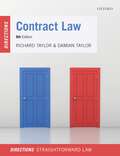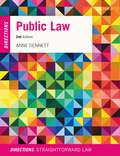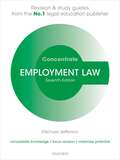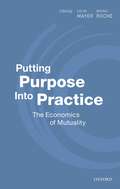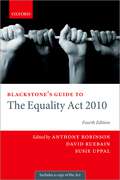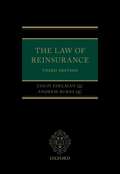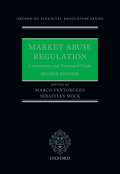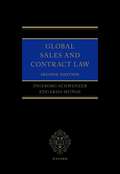- Table View
- List View
Mayson, French & Ryan on Company Law
by Derek FrenchMayson, French & Ryan on Company Law is the ideal companion for students looking for a comprehensive and straightforward account of company law. With hallmark clarity, this new edition continues the tradition of providing accurate technical detail, examination of theory and quotations from key cases. The content has been streamlined with modern company law courses in mind and presented in numerous helpful features . Consistently praised for thorough yet accessible handling of the law, Mayson, French & Ryan on Company Law has positioned itself as the go-to company law text for the modern student. Digital formats and resources This edition is available for students and institutions to purchase in a variety of formats, and is supported by online resources. The e-book offers a mobile experience and convenient access along with functionality tools, navigation features, and links that offer extra learning support: www.oxfordtextbooks.co.uk/ebooks This edition is also accompanied by a selection of online resources to support and further student learning, including four bonus chapters on transparency, accounts, marketable loans, and legal forms for businesses.
Mayson, French & Ryan on Company Law
by Derek FrenchMayson, French & Ryan on Company Law is the ideal companion for students looking for a comprehensive and straightforward account of company law. With hallmark clarity, this new edition continues the tradition of providing accurate technical detail, examination of theory and quotations from key cases. The content has been streamlined with modern company law courses in mind and presented in numerous helpful features . Consistently praised for thorough yet accessible handling of the law, Mayson, French & Ryan on Company Law has positioned itself as the go-to company law text for the modern student. Digital formats and resources This edition is available for students and institutions to purchase in a variety of formats, and is supported by online resources. The e-book offers a mobile experience and convenient access along with functionality tools, navigation features, and links that offer extra learning support: www.oxfordtextbooks.co.uk/ebooks This edition is also accompanied by a selection of online resources to support and further student learning, including four bonus chapters on transparency, accounts, marketable loans, and legal forms for businesses.
Contract Law Directions (Directions)
by Richard Taylor Damian TaylorThe Directions series has been written with students in mind. Contract Law Directions is the ideal guide as they approach the subject for the first time, this book will help them: - Gain a complete understanding of the topic: we won't overload or leave your students short, just the right amount of detail conveyed clearly - Understand the law in context: with scene-setting introductions and highlighted case extracts, the practical importance of the law becomes clear - Identify when and how to evaluate the law critically: students will be introduced to the key areas of debate and given the confidence to question the law - Deepen and test knowledge: visually engaging learning and self-testing features aid understanding and help students tackle assessments with confidence - Elevate their learning: with the ground-work in place, your students can aspire to take their learning to the next level, with direction provided on how to go further, each chapter now has a 'digging deeper' feature to further develop understanding Digital formats and resources The eighth edition is available for students and institutions to purchase in a variety of formats, and is supported by online resources. The e-book offers a mobile experience and convenient access, along with functionality tools, navigation features, and links that offer extra learning support: www.oxfordtextbooks.co.uk/ebooks The text is also supported by online resources, which include: - Self-test questions - Guidance on answering essay and problem questions - Web links - Flashcard glossary Additional lecturer resources include: - Diagrams from the book
Public Law Directions (Directions)
by Anne DennettThe Directions series has been written with students in mind. The ideal guide as they approach the subject for the first time, this book will help them: · Gain a complete understanding of the topic: just the right amount of detail conveyed clearly · Understand the law in context: with scene-setting introductions and highlighted case extracts, the practical importance of the law becomes clear · Identify when and how to evaluate the law critically: they'll be introduced to the key areas of debate and given the confidence to question the law · Deepen and test knowledge: visually engaging learning and self-testing features aid understanding and help students tackle assessments with confidence · Elevate their learning: with the ground-work in place your students can aspire to take their learning to the next level, with direction provided on how to go further Digital formats and resources Public Law Directions is available for students and institutions to purchase in a variety of formats, and is supported by online resources. · The e-book offers a mobile experience and convenient access along with functionality tools, navigation features and links that offer extra learning support: www.oxfordtextbooks.co.uk/ebooks · The online resources include self-test questions with instant feedback, guidance on answering the questions from the book, updates on the law, and flowcharts with audio.
Employment Law Concentrate (PDF): Law Revision and Study Guide
by Michael JeffersonEmployment Law Concentrate is written and designed to help you succeed. Written by experts and covering all key topics, Concentrate guides go above and beyond, not only consolidating your learning but focusing your revision and maximising your exam performance. Each guide includes revision tips, advice on how to achieve extra marks, and a thorough and focused breakdown of the key topics and cases.
Putting Purpose Into Practice: The Economics of Mutuality
In the face of constant change, the nature of business must evolve rapidly if it is to remain relevant to society at large. How then should business change to meet the requirements of the 21st century, in which unbridled globalization and technological advancements are having profound affects on the wellbeing and prosperity of both the people and the planet? The achievement of purpose is the key to successful transformation - not just having a purpose, but making that purpose real at every level of the organization. This is the first book to provide a precise description of how companies can put purpose into practice. Based on a groundbreaking research project undertaken jointly between the Saïd Business School at the University of Oxford and Mars Catalyst, the think tank of Mars Inc., it provides a highly accessible account of how companies should determine and implement their corporate purposes. It outlines why corporate purpose is so important and how it can both address the major challenges the world faces today and deliver enhanced performance for business. Fourteen detailed case studies illustrate how companies of different sizes, sectors, and geographies have put purpose into practice and their experiences of doing so. These cases give deep insights into the way in which companies can build purposeful businesses, map and shape their ecosystems, identify failures and problems, align management, and create partnerships to deliver their purposes against which they can measure their performance. The achievement of purpose is a very real issue that every responsible leader in business, finance, and business academia must now face. This book will equip executives, managers, investors, and policymakers with the tools that they require to understand how the notion of corporate purpose should become a corporate reality.
Putting Purpose Into Practice: The Economics of Mutuality
by Bruno Roche Colin MayerIn the face of constant change, the nature of business must evolve rapidly if it is to remain relevant to society at large. How then should business change to meet the requirements of the 21st century, in which unbridled globalization and technological advancements are having profound affects on the wellbeing and prosperity of both the people and the planet? The achievement of purpose is the key to successful transformation - not just having a purpose, but making that purpose real at every level of the organization. This is the first book to provide a precise description of how companies can put purpose into practice. Based on a groundbreaking research project undertaken jointly between the Saïd Business School at the University of Oxford and Mars Catalyst, the think tank of Mars Inc., it provides a highly accessible account of how companies should determine and implement their corporate purposes. It outlines why corporate purpose is so important and how it can both address the major challenges the world faces today and deliver enhanced performance for business. Fourteen detailed case studies illustrate how companies of different sizes, sectors, and geographies have put purpose into practice and their experiences of doing so. These cases give deep insights into the way in which companies can build purposeful businesses, map and shape their ecosystems, identify failures and problems, align management, and create partnerships to deliver their purposes against which they can measure their performance. The achievement of purpose is a very real issue that every responsible leader in business, finance, and business academia must now face. This book will equip executives, managers, investors, and policymakers with the tools that they require to understand how the notion of corporate purpose should become a corporate reality.
Identity and Diversity on the International Bench: Who is the Judge? (International Courts and Tribunals Series)
International courts and tribunals hold the power to decide on questions involving sovereignty over territory, grave human rights violations, international crimes, or millions of euros' worth of economic interests. Judges and arbitrators are the 'faces' and arguably the drivers of international adjudication. Yet certain groups tend to be overrepresented on international benches, while others remain underrepresented. Although international courts and tribunals differ in their institutional make-up and functions, they all rely in essence on the judgement of a group of individuals, each with their own background and experience. Even if adjudicators' identity is not the only, and may not be the decisive, influence on their decision-making, the relative lack of diversity has an effect on the judicial process and its outcomes, which in turn entails broader implications for the legitimacy of international law. This book analyses the implications of identity and diversity across numerous international adjudicatory bodies, focusing on a wide range of factors. Lack of diversity within the judiciary has been identified as a legitimacy concern in domestic settings, and the last few years have seen increasing attention to this question at the international level as well, making the book both timely and topical.
Identity and Diversity on the International Bench: Who is the Judge? (International Courts and Tribunals Series)
by Freya BaetensInternational courts and tribunals hold the power to decide on questions involving sovereignty over territory, grave human rights violations, international crimes, or millions of euros' worth of economic interests. Judges and arbitrators are the 'faces' and arguably the drivers of international adjudication. Yet certain groups tend to be overrepresented on international benches, while others remain underrepresented. Although international courts and tribunals differ in their institutional make-up and functions, they all rely in essence on the judgement of a group of individuals, each with their own background and experience. Even if adjudicators' identity is not the only, and may not be the decisive, influence on their decision-making, the relative lack of diversity has an effect on the judicial process and its outcomes, which in turn entails broader implications for the legitimacy of international law. This book analyses the implications of identity and diversity across numerous international adjudicatory bodies, focusing on a wide range of factors. Lack of diversity within the judiciary has been identified as a legitimacy concern in domestic settings, and the last few years have seen increasing attention to this question at the international level as well, making the book both timely and topical.
Blackstone's Guide to the Equality Act 2010 (Blackstone's Guides)
The Equality Act 2010 was an extremely significant reform of the UK discrimination law, consolidating the existing mass of statutory provisions into one statute. The Act brought new rights against discrimination and imposed new duties on employers, service providers, and public authorities. It defined nine protected characteristics: age, disability, combined grounds, gender reassignment, marriage and civil partnership, race, religion or belief, sex, and sexual orientation. This fully revised edition covers all recent developments in the law relating to the Equality Act 2010 and considers the impact of exiting the EU, the transitional period, and the implications for the interaction of the Equality Act and EU law post-Brexit. This title includes new cases and judgements in several key sectors, such as employment rights, education, premises, public sector, enforcement, and positive action. Combining the full text of the Act, as amended, with narrative from an expert team, the book is an invaluable resource for all who encounter the evolving legislation. The Blackstone's Guide Series delivers concise and accessible books covering the latest legislative changes and amendments. Published soon after enactment, they provide expert commentary by leading names on the extent, scope, and effects of the legislation, and include a full copy of the Act itself. They offer a cost-effective solution to key information needs and are the perfect companion for any practitioner needing to get up to speed with the latest changes.
Blackstone's Guide to the Equality Act 2010 (Blackstone's Guides)
by Anthony Robinson, David Ruebain, and Susie UppalThe Equality Act 2010 was an extremely significant reform of the UK discrimination law, consolidating the existing mass of statutory provisions into one statute. The Act brought new rights against discrimination and imposed new duties on employers, service providers, and public authorities. It defined nine protected characteristics: age, disability, combined grounds, gender reassignment, marriage and civil partnership, race, religion or belief, sex, and sexual orientation. This fully revised edition covers all recent developments in the law relating to the Equality Act 2010 and considers the impact of exiting the EU, the transitional period, and the implications for the interaction of the Equality Act and EU law post-Brexit. This title includes new cases and judgements in several key sectors, such as employment rights, education, premises, public sector, enforcement, and positive action. Combining the full text of the Act, as amended, with narrative from an expert team, the book is an invaluable resource for all who encounter the evolving legislation. The Blackstone's Guide Series delivers concise and accessible books covering the latest legislative changes and amendments. Published soon after enactment, they provide expert commentary by leading names on the extent, scope, and effects of the legislation, and include a full copy of the Act itself. They offer a cost-effective solution to key information needs and are the perfect companion for any practitioner needing to get up to speed with the latest changes.
The Law of Reinsurance
by Colin Edelman, QC Andrew Burns, QCThis concise and accessible guide to reinsurance law is an easy-to-read specialist reference focusing solely on reinsurance. Every aspect of the core and subsidiary principles of reinsurance law are covered beginning with an investigation of the definition, purpose, and types of reinsurance. Guidance is given on contractual principles and terms in the reinsurance context, obligations, rights and liabilities of the reinsurer, and the choice of law. With usability and practicality in mind, a number of aspects have been further developed in this edition. There is an increased depth of analysis in addressing 'Follow the Settlements', incorporation, non-disclosure, misrepresentation, and the role of good faith in reinsurance contracts. The new edition also addresses the consequences of the Insurance Act 2015 and recent cases on reinsurance arbitration - particularly the appointment of arbitrators and their duties. This book is both practical and authoritative, and is successful in isolating the key issues in reinsurance law to provide an easy and reliable reference source. It is a must-have work for all reinsurance practitioners.
The Law of Reinsurance
by Colin Edelman, QC Andrew Burns, QCThis concise and accessible guide to reinsurance law is an easy-to-read specialist reference focusing solely on reinsurance. Every aspect of the core and subsidiary principles of reinsurance law are covered beginning with an investigation of the definition, purpose, and types of reinsurance. Guidance is given on contractual principles and terms in the reinsurance context, obligations, rights and liabilities of the reinsurer, and the choice of law. With usability and practicality in mind, a number of aspects have been further developed in this edition. There is an increased depth of analysis in addressing 'Follow the Settlements', incorporation, non-disclosure, misrepresentation, and the role of good faith in reinsurance contracts. The new edition also addresses the consequences of the Insurance Act 2015 and recent cases on reinsurance arbitration - particularly the appointment of arbitrators and their duties. This book is both practical and authoritative, and is successful in isolating the key issues in reinsurance law to provide an easy and reliable reference source. It is a must-have work for all reinsurance practitioners.
Artificial Intelligence and Intellectual Property
Artificial Intelligence (AI) has become omnipresent in today's business environment: from chatbots to healthcare services to various ways of creating useful information. While AI has been increasingly used to optimize various creative and innovative processes, the integration of AI into products, services, and other operational procedures raises significant concerns across virtually all areas of intellectual property (IP) law. While AI has drawn extensive attention from IP experts globally, this is the first book providing a broad and comprehensive picture from the perspectives of the very nature of AI technology, its commercial implications, its interaction with different kinds of IP, IP administration, software and data, its social and economic impact on the innovation policy, and ultimately AI's eligibility as a legal entity.
Artificial Intelligence and Intellectual Property
by Jyh-An Lee, Reto M Hilty, and Kung-Chung LiuArtificial Intelligence (AI) has become omnipresent in today's business environment: from chatbots to healthcare services to various ways of creating useful information. While AI has been increasingly used to optimize various creative and innovative processes, the integration of AI into products, services, and other operational procedures raises significant concerns across virtually all areas of intellectual property (IP) law. While AI has drawn extensive attention from IP experts globally, this is the first book providing a broad and comprehensive picture from the perspectives of the very nature of AI technology, its commercial implications, its interaction with different kinds of IP, IP administration, software and data, its social and economic impact on the innovation policy, and ultimately AI's eligibility as a legal entity.
Market Abuse Regulation: Commentary and Annotated Guide (Oxford EU Financial Regulation)
Now a volume in the Oxford EU Financial Regulation Series, the second edition of Market Abuse Regulation has been updated to reflect the impact of a number of major developments in legislation and case law following the implementation of the EU Market Abuse Regulation (MAR). Written by leading scholars in the field of capital markets law from a number of European jurisdictions, the book is divided into two main parts. The first consists of chapters considering relevant issues by topic, including aspects not directly addressed by MAR such as enforcement, and the impact of US securities regulation. The second part provides article-by-article commentary on the Regulation, with a detailed and technical analysis of its terms. Both parts have been updated to reflect important developments such as amendments to directives and new regulations regarding the promotion of the use of SME growth markets. The second edition includes additional chapters on sanctions. One new chapter deals exclusively with the criminal sanctions (including CRIM-MAD), and another addresses in much greater detail private enforcement in key jurisdictions (France, Germany, Italy, the Netherlands and Spain), which is neither addressed by the MAR nor harmonized by other European legislation. This chapter on private enforcement is also accompanied by another dealing with aspects of private international and international civil procedural law. The existing chapters have also been updated to bring them fully up to date.
Market Abuse Regulation: Commentary and Annotated Guide (Oxford EU Financial Regulation)
by Marco Ventoruzzo, Sebastian MockNow a volume in the Oxford EU Financial Regulation Series, the second edition of Market Abuse Regulation has been updated to reflect the impact of a number of major developments in legislation and case law following the implementation of the EU Market Abuse Regulation (MAR). Written by leading scholars in the field of capital markets law from a number of European jurisdictions, the book is divided into two main parts. The first consists of chapters considering relevant issues by topic, including aspects not directly addressed by MAR such as enforcement, and the impact of US securities regulation. The second part provides article-by-article commentary on the Regulation, with a detailed and technical analysis of its terms. Both parts have been updated to reflect important developments such as amendments to directives and new regulations regarding the promotion of the use of SME growth markets. The second edition includes additional chapters on sanctions. One new chapter deals exclusively with the criminal sanctions (including CRIM-MAD), and another addresses in much greater detail private enforcement in key jurisdictions (France, Germany, Italy, the Netherlands and Spain), which is neither addressed by the MAR nor harmonized by other European legislation. This chapter on private enforcement is also accompanied by another dealing with aspects of private international and international civil procedural law. The existing chapters have also been updated to bring them fully up to date.
The New European Central Bank: Taking Stock and Looking Ahead
by Thomas Beukers Diane Fromage Giorgio MontiThe European Central Bank (ECB) was first introduced in the European legal order on the occasion of the Treaty of Maastricht (1992). An official EU institution which is governed by EU law, the ECB of modern times differs vastly from its inception in 1998, which manifests in three main ways: monetary policy options, consideration of concerns other than low inflation in its policy-making, and its role in the Banking Union. This edited collection offers a retrospective and prospective account of the ECB, charting its evolution in detail with chapters written by leading academics and practitioners. Part 1 examines the substantive changes to monetary policy introduced by the ECB as a consequence of the financial and sovereign debt crisis by considering their legal basis. Part 2 moves beyond monetary policy by shifting to the new roles that the ECB has been called upon to play, notably in banking supervision and resolution. Parts 3 and 4 deal with transformations to inter- and intra-institutional relations, and take stock of these transformations, reflecting on the nature of the ECB of current times and which direction it could be heading in the future. The authors analyse the most salient and controversial elements of the ECB's crisis response, including unconventional monetary policy measures and the ECB's risk management strategy. Beyond monetary policy, the book further examines the role played by objectives such as financial stability and environmental sustainability, the ECB's relationship to the Lender of Last Resort function, as well as its new responsibilities in the Banking Union.
The New European Central Bank: Taking Stock and Looking Ahead
by Thomas Beukers Diane Fromage Giorgio MontiThe European Central Bank (ECB) was first introduced in the European legal order on the occasion of the Treaty of Maastricht (1992). An official EU institution which is governed by EU law, the ECB of modern times differs vastly from its inception in 1998, which manifests in three main ways: monetary policy options, consideration of concerns other than low inflation in its policy-making, and its role in the Banking Union. This edited collection offers a retrospective and prospective account of the ECB, charting its evolution in detail with chapters written by leading academics and practitioners. Part 1 examines the substantive changes to monetary policy introduced by the ECB as a consequence of the financial and sovereign debt crisis by considering their legal basis. Part 2 moves beyond monetary policy by shifting to the new roles that the ECB has been called upon to play, notably in banking supervision and resolution. Parts 3 and 4 deal with transformations to inter- and intra-institutional relations, and take stock of these transformations, reflecting on the nature of the ECB of current times and which direction it could be heading in the future. The authors analyse the most salient and controversial elements of the ECB's crisis response, including unconventional monetary policy measures and the ECB's risk management strategy. Beyond monetary policy, the book further examines the role played by objectives such as financial stability and environmental sustainability, the ECB's relationship to the Lender of Last Resort function, as well as its new responsibilities in the Banking Union.
Charting Limitations on Trademark Rights
Trademark scholarship has focused largely on the protection of trademark rights against consumer confusion and the dilution of trademarks. Studies of limitations on trademark rights, meanwhile, have remained relatively peripheral, especially in jurisdictions outside of the United States. However, this reality is incongruous with the importance of the limitations, such as descriptive and nominative uses, in promoting freedom of commerce, market competition, free speech, and cultural dynamics. Against this backdrop, Charting Limitations on Trademark Rights is the first comprehensive academic volume detailing limitations in trademark rights from both theoretical and comparative perspectives. The book presents new theoretical perspectives to justify trademark rights limitations, re-examines the nature of these limitations, delineates the scope of the limitations, and offers comparative studies of the limitations. With contributions from leading trademark scholars in the EU, US, and Asia, this is a must read for scholars, students, practitioners, and policymakers with an interest in the theories, policies, and doctrines of trademark law.
Charting Limitations on Trademark Rights
by Haochen Sun Barton BeebeTrademark scholarship has focused largely on the protection of trademark rights against consumer confusion and the dilution of trademarks. Studies of limitations on trademark rights, meanwhile, have remained relatively peripheral, especially in jurisdictions outside of the United States. However, this reality is incongruous with the importance of the limitations, such as descriptive and nominative uses, in promoting freedom of commerce, market competition, free speech, and cultural dynamics. Against this backdrop, Charting Limitations on Trademark Rights is the first comprehensive academic volume detailing limitations in trademark rights from both theoretical and comparative perspectives. The book presents new theoretical perspectives to justify trademark rights limitations, re-examines the nature of these limitations, delineates the scope of the limitations, and offers comparative studies of the limitations. With contributions from leading trademark scholars in the EU, US, and Asia, this is a must read for scholars, students, practitioners, and policymakers with an interest in the theories, policies, and doctrines of trademark law.
Global Sales and Contract Law
by Ingeborg Schwenzer Edgardo MuñozThe second edition of Global Sales and Contract Law continues to provide comparative analysis of domestic laws of sale and contract in over sixty countries, delivering a global view of national and international sales law. The book is grounded in the practical realities of sales law, reflecting the day-to-day issues faced by practitioners. Complex questions of the obligations under a sales contract, the ways in which these are established, as well as the remedies following the breach of obligations, are all analysed. In addition to coverage of the CISG and various national regimes, the book examines regional projects, like the the UNIDROIT PICC, the PECL, the DCFR and the PLACL, and compares differences in domestic legal approach where the CISG would not apply. The new edition covers all the relevant case law, and factors in developments such as changes to the law of contract in Argentina, France, Hungary, and Japan, a raft of countries which have adopted the CISG since the first edition, updates to the UNIDROIT PICC, and new editions of the ICC's INCOTERMS© and force majeure and hardship clauses in 2020. International or multilateral developments that were envisaged in the original edition have now either evolved or disappeared, for example, the European Union's plan for a Common European Sales Law (CESL), as reflected in the new edition. Encompassing all aspects of sale of goods transactions, and examining the process of a sale with relation to general contract law, the book gives practitioners invaluable insight into judicial trends and possible solutions in different legal systems, whether preparing for litigation or drafting an international contract. Global Sales and Contract Law remains the most comprehensive and thorough compilation of legal analysis in the field of the sale of goods and is a source for any practitioner dealing in international commerce.
Global Sales and Contract Law
by Ingeborg Schwenzer Edgardo MuñozThe second edition of Global Sales and Contract Law continues to provide comparative analysis of domestic laws of sale and contract in over sixty countries, delivering a global view of national and international sales law. The book is grounded in the practical realities of sales law, reflecting the day-to-day issues faced by practitioners. Complex questions of the obligations under a sales contract, the ways in which these are established, as well as the remedies following the breach of obligations, are all analysed. In addition to coverage of the CISG and various national regimes, the book examines regional projects, like the the UNIDROIT PICC, the PECL, the DCFR and the PLACL, and compares differences in domestic legal approach where the CISG would not apply. The new edition covers all the relevant case law, and factors in developments such as changes to the law of contract in Argentina, France, Hungary, and Japan, a raft of countries which have adopted the CISG since the first edition, updates to the UNIDROIT PICC, and new editions of the ICC's INCOTERMS© and force majeure and hardship clauses in 2020. International or multilateral developments that were envisaged in the original edition have now either evolved or disappeared, for example, the European Union's plan for a Common European Sales Law (CESL), as reflected in the new edition. Encompassing all aspects of sale of goods transactions, and examining the process of a sale with relation to general contract law, the book gives practitioners invaluable insight into judicial trends and possible solutions in different legal systems, whether preparing for litigation or drafting an international contract. Global Sales and Contract Law remains the most comprehensive and thorough compilation of legal analysis in the field of the sale of goods and is a source for any practitioner dealing in international commerce.
Brexit and the Future of the European Union: The Case for Constitutional Reforms
by Federico FabbriniBrexit represents a momentous event for the European Union, with important implications on the future of Europe. While most scholarly attention has focused on the Brexit process and its consequences for the United Kingdom, and UK-EU relations, Brexit has had important consequences also for the EU. This book examines how the EU has changed during Brexit and because of Brexit, while also reflecting on the developments of the EU besides Brexit and beyond Brexit. As the book argues, the UK withdrawal from the EU - the first ever case of disintegration since the start of the European integration process - creates an urgent need to reform the EU. In fact, while the EU institutions and its member states have remained united in their negotiations vis-à-vis the UK, Brexit has created transitional problems for the EU, and exposed other serious fissures in its system of governance which need to be addressed moving forward. As the EU goes through another major crisis in the form of the response to the Covid-19 pandemic, the case for increasing the effectiveness and the legitimacy of the EU grows stronger. In this context, the book analyses the plan to establish a Conference on the Future of Europe, examines its precedents and discusses its prospects. As the book suggests that, after Brexit, the initiative to launch a Conference on the Future of Europe is a necessary step to renew the EU and relaunch integration.
Brexit and the Future of the European Union: The Case for Constitutional Reforms
by Federico FabbriniBrexit represents a momentous event for the European Union, with important implications on the future of Europe. While most scholarly attention has focused on the Brexit process and its consequences for the United Kingdom, and UK-EU relations, Brexit has had important consequences also for the EU. This book examines how the EU has changed during Brexit and because of Brexit, while also reflecting on the developments of the EU besides Brexit and beyond Brexit. As the book argues, the UK withdrawal from the EU - the first ever case of disintegration since the start of the European integration process - creates an urgent need to reform the EU. In fact, while the EU institutions and its member states have remained united in their negotiations vis-à-vis the UK, Brexit has created transitional problems for the EU, and exposed other serious fissures in its system of governance which need to be addressed moving forward. As the EU goes through another major crisis in the form of the response to the Covid-19 pandemic, the case for increasing the effectiveness and the legitimacy of the EU grows stronger. In this context, the book analyses the plan to establish a Conference on the Future of Europe, examines its precedents and discusses its prospects. As the book suggests that, after Brexit, the initiative to launch a Conference on the Future of Europe is a necessary step to renew the EU and relaunch integration.

